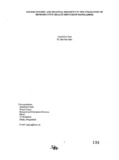Socioeconomic and regional disparity in the utilization of reproductive health services in Bangladesh
Citation
Hadi, A., & Gani, M. S. (2003). Socioeconomic and regional disparity in the utilization of reproductive health services in Bangladesh. Research Reports (2003): Health Studies, Vol - XXXV, 133–153.Abstract
Although the health care system has significantly expanded in Bangladesh during the last two decades,
the health status of the population has remained very poor because of the uneven distribution of services.
Inequality in health exists in many forms and multiple dimensions such as age, sex, education, income,
ethnicity, etc. Using data from a nationally representative sample, this study attempts to improve our
understanding about the socioeconomic and regional disparity in the utilization of reproductive health
services in Bangladesh.
Data for this study came from the demographic and health surveillance system of BRAe which
provided the updated information of the ownership of household asset and the use of reproductive health
services. Socioeconomic disparity was measured by constructing a wealth index using compound assets
and possessions of a set of household wealth. The surveillance areas were categorized into four regions
as urban slum, rural under-served, other rural and the hill tracts. The utilization of reproductive health
services was measured by the use of ante and postnatal care, maternal immunization coverage, and the
use of safe delivery. A total of 1,182 randomly selected women, who gave birth in 200 I, were
interviewed.
Findings revealed significant socioeconomic and regional differentials in the use of reproductive
health services. The use of services was much lower among the extreme poor than the non-poor and
among the ethnic minorities in the hill and rural under-served than the other regions. The region specific
inequalities, which were greater than the socioeconomic inequalities, may be reduced by expanding
outreach health programs to bring services closer to the disadvantaged. The study concludes that much
of these inequalities are social constructs that can be reduced by prioritizing the needs of the
disadvantaged and adopting appropriate policy change options.

